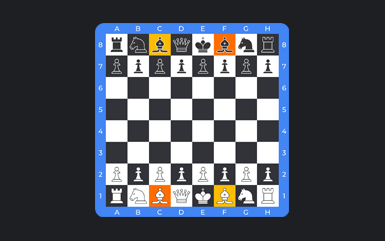The Bishop Chess Piece – Starting Position, Movements, Values, and Role
The Bishop, with its diagonal movements, adds a dynamic layer to the game of chess. Each player begins the game with two Bishops, and knowing how to use them effectively can greatly enhance your strategy. In this blog post, we’ll delve into everything about the Bishop, from its characteristics and movements to its strategic value in the game of chess.
What is a Bishop?
The Bishop is one of the major pieces in the game of chess. Each player begins the game with two Bishops. One starts on a light-colored square, and the other on a dark-colored square. This pair can control both color complexes on the board, which makes them strategically important in chess.
Where does the Bishop Start on the Board?
In the initial setup of the game, the Bishops are placed next to the King and Queen. In standard algebraic notation, the white Bishops start on squares c1 (light-squared Bishop) and f1 (dark-squared Bishop), while the black Bishops start on squares c8 and f8, respectively.
How does the Bishop Move on the Chessboard?
The Bishop moves diagonally any number of squares, in any direction, as long as its path isn’t obstructed by another piece. It cannot jump over pieces. Importantly, each Bishop remains on the color of square it started the game on.
How much Points is Bishop Worth?
In the traditional point system used in chess to denote the relative values of pieces, the Bishop is worth 3 points. This is the same value as the Knight, though the two pieces have very different strengths and weaknesses.
What is the Role of the Bishop in Chess?
The Bishops can serve various roles in a game of chess. In the opening, they’re often developed to squares that control the center or pin opponent’s pieces. In the middlegame, Bishops can be powerful attackers and defenders, especially when the board is open and they can exploit their long-range movement. In the endgame, the Bishop’s ability to quickly travel from one end of the board to the other can be extremely valuable.
How to Maximize the Bishop’s Potential in Chess?
Maximizing the Bishop’s potential largely comes down to making the most of its long-range, diagonal movement. Here are some strategies:
- Bishop Pair: If you can maintain both of your Bishops while your opponent loses one, you’ll have the “Bishop pair” advantage, especially effective in open positions.
- Diagonal Control: Position your Bishops on long diagonals, where they can exert pressure on many squares.
- Coordinate with Pawns: Pawns that are placed on squares of the opposite color to your Bishop can help create a harmonious setup, as the pawns and Bishop complement each other by controlling different colored squares.
Are there any Special Rules for the Bishop?
Unlike the King and the Castle (Rook), the Bishop doesn’t have any special moves like castling. However, the way it combines with other pieces, particularly in coordinating with pawns and in conjunction with the other Bishop, can lead to complex strategic implications.
Alternative Names for the Bishop Chess Piece?
The Bishop is known by different names in different languages. For example, in French, it’s called ‘Fou,’ in Spanish, ‘Alfil,’ and in German, ‘Läufer.’ However, the term ‘Bishop’ is the universally accepted name in English-language chess.
Conclusion
The Bishop is a unique piece that adds a dash of dynamism and strategic depth to chess. Its long-range, diagonal movement can prove to be quite potent when utilized effectively. As you grow as a chess player, understanding the power and potential of the Bishop will become increasingly important. Remember, the beauty of chess lies in the intricate interplay of its pieces, and the Bishop, with its unique moves and positions, is an integral part of that. So, study it, understand it, and let it be a vital part of your chess strategy. Happy gaming!




 Protected by Patchstack
Protected by Patchstack
0 Comments